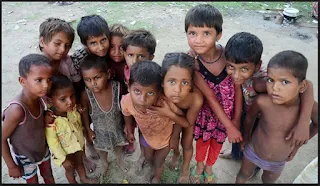India is really a land of hypo-critics. We boast of being the world power and then we at the same time ignore the future of the country by ignoring the needs of the poor children. Their health and education from the time they are born to the time they become a part of the productive workforce of the country. The negligence of their special needs has led to the chronic cycle of poverty for the rural poor and tribal population.
Why Malnutrition in Indian Children
The realisation that India is facing child malnutrition crisis worse than in most African countries, India should finally wake to the scale of the problem.
According to the Lancet study , India´s biggest problem is the number of young anaemic mothers 55.8 percent of adolescents aged between 15 and 19 years and 56.7 percent of women aged between 20 and 24 years were found to be anaemic and eleven percent of adolescent girls in India were found to be underweight. The global prevalence of stunting has gradually decreased in the past 20 years, but still remains high in absolute numbers. The researchers of the study estimate that stunting affected at least 165 million children worldwide in 2011. Many children are born to teenage, anaemic, malnourished mothers; feeding practises are poor; and the environment they live in, a crowded country where 600 million people have no access to toilets, is rife with faecal matter. It seems that the government lacks a coherent plan to overcome the shortcomings of the child health programme, which depends on village health workers who are overburdened and poorly educated, trained and paid.
According to the Lancet study , India´s biggest problem is the number of young anaemic mothers 55.8 percent of adolescents aged between 15 and 19 years and 56.7 percent of women aged between 20 and 24 years were found to be anaemic and eleven percent of adolescent girls in India were found to be underweight. The global prevalence of stunting has gradually decreased in the past 20 years, but still remains high in absolute numbers. The researchers of the study estimate that stunting affected at least 165 million children worldwide in 2011. Many children are born to teenage, anaemic, malnourished mothers; feeding practises are poor; and the environment they live in, a crowded country where 600 million people have no access to toilets, is rife with faecal matter. It seems that the government lacks a coherent plan to overcome the shortcomings of the child health programme, which depends on village health workers who are overburdened and poorly educated, trained and paid.
Effects of Malnutrinution on Health
Malnutrition affects children´s chances of survival, increases their susceptibility to illness, reduces their ability to learn, increases their chances of dropping out early from school, and makes them less productive in later life. Much of this undernourishment happens during pregnancy and in the first two years of a child´s life and, without appropriate interventions, the damage to brain development and future economic productivity is largely irreversible.
Given it impact on health, education and economic productivity, persistent under-nutrition is a major obstacle to human development, impacting India´s much awaited demographic dividend and the countries prospects for future economic growth.
Conclusions
It's pretty unusual, that there seems to be a cyclical situation. Growth is needed urgently, the fruits of growth are needed also, and both seem to be the continuous cause of each other. In the west, it appears that because growth is required, and due to globalization, the western nations need a continuous short cycle of recovery, and then economic slump, in very short periods. There is indication of recovery, and then slump, in the news, as it is perceived. Perhaps, very minute specialization in knowledge application is the cause. There needs to be a continuum in economic sustenance.
By Shashikant Nishant Sharma











